Clayarch Gimhae Museum’s special exhibition “Post-human: Humans after Humans” inquires what impact technological development has on humans, especially artists, and how art and technology can coexist. AI (artificial intelligence) robots, 3D printers and digital drawings, symbolic of future society, paradoxically emphasize human beings’ primordial power to think, create and experience.
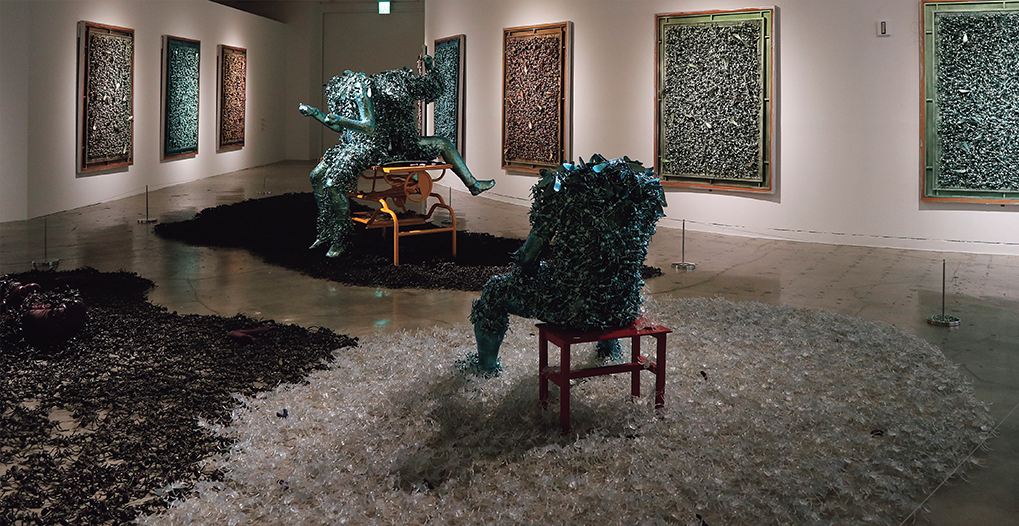
“The Sealed Paradigm” series (walls) by Kim Hong-jin. 2017. Mixed media injection, 3D printer, 187 x 147 x 12 cm.“Objects on the Operating Table” (left) by Kim Hong-jin. 2018. Mixed media injection, casting, 180 x 150 x 180 cm. “A Spectator” (right) by Kim Hong-jin. 2018. Mixed media injection, casting, 130 x 130 x 180 cm.“A Process of Extinction” (floor) by Kim Hong-jin. 2018. Mixed media injection, casting, 300 x 300 x 50 cm.
“Are you human?” I whisper into the ear of the robot hanging in midair in supine position.
“I don’t think I’m human. But I could become one soon. I’m trying this hard, as you see,” the robot answers with its lips moving.
“What is it about being human that makes the robot work so hard?” I wonder to myself. Pity, rather than fear, of the robot’s grotesque exterior overwhelms me.
“Look at me,” I say to the robot.
The robot rolls its big eyes in my direction and shoots me a question of its own: “Why are you here alone?”
I was told the android in GAIA’s brain accesses the artist’s webpage server when a visitor makes small talk, finds a proper response and emits it in the form of voice. The combinations of questions and answers are frequently updated and thereby diversified. In her seemingly bizarre work, entitled “An Evolving GAIA,” Roh Jin-ah asks how humans and machines will relate to one another and what kind of future they will share together further down the road of evolution when the two might be hardly distinguishable from each other.
The special exhibition, entitled “Post-human: Humans after Humans,” runs through March 24 this year at the Clayarch Gimhae Museum in South Gyeongsang Province. Focusing on the future, artists share their concerns about the potential replacement of human labor by AI in the age of the fourth industrial revolution. The exhibition shows the results of long and hard thinking about the sustainability of art; for example, how the convergence of art and science will manifest itself, and how art can maintain its unique voice amidst rapid technological advances. The exhibition has multied flavors - a sense of pessimism forecasting the end of civilization, a note of optimism about how science and technology have made our lives more convenient, and a dash of imagination going beyond planet earth.

“An Evolving GAIA” by Roh Jin-ah. 2017. Resin, wood, interactive system, variable installation, approximately 4.5 m long.
Multied Flavors
Dozens of white and gold robots from an identical mold are lined up on a conveyor belt. Next to it, a large Taekwon V robot stands on top of a pedestal resembling a transmission tower, though failing to conceal its protruding belly. This is Shin Yi-chul’s “Robot Taekwon Boy.” The hero robots from our childhood memories have crossed over from dreams and imagination to the real world, showing up as friends one can talk to, like pet animals, or even as chefs or guides.
“The Sealed Paradigm” series by Kim Hong-jin features cookie-cutter ants made from 3D printers lining the floor and walls of the exhibition hall. The artist seems to be asking how different we humans are from the 3D-printed ants since it has become difficult in this modern society to claim our individual identity. The large rectangular frames on the walls each have seeds, rice, barley, wheat and twigs on the bottom, with model ants covering them up - a mixture of materials that seems to symbolize the paradigm of survival.
In the adjoining room is Sim Jun-seub’s installation, entitled “Circulation of Organ.” Twisted pipes attached to the wall resemble the insides of a human body. When visitors walk into the darkened room, the pipes light up in fluorescent colors and make sounds from different holes according to their movement. Only with the participation of the viewers is this work complete. With this work of art that is the visualization of sound, the artist raises the idea that invisible sound can distort space.
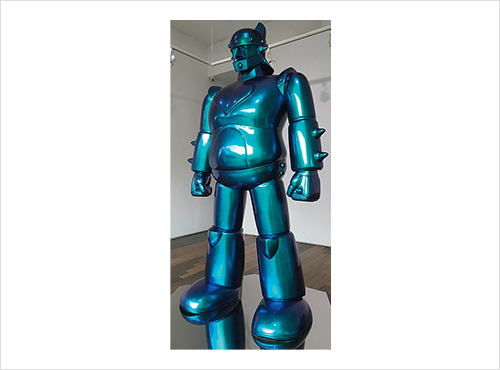
“Larchiveum” by Shin Yi-chul. 2017. White porcelain, gold leaf, slip casting, variable installation, 48 × 30 × 11 cm. (each robot, total 80 robots).
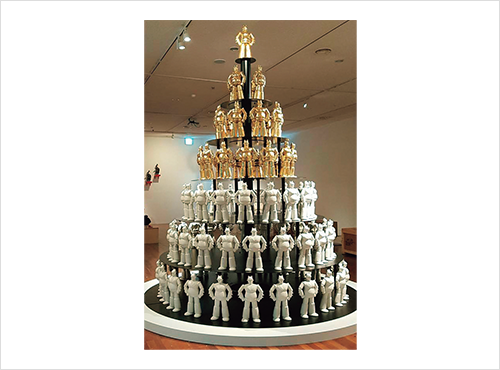
“Robot Taekwon Boy” by Shin Yi-chul. 2016. Aluminum, aluminum casting, urethane paint, 220 × 100 × 50 cm.
Mother Nature, Still Relevant
The second floor of the exhibition space is devoted to collaborative works. The shelves at the entrance are lined with plants, and abstract paintings resembling submarine creatures are placed in the middle. These paintings of gouache blurred on the canvas have been installed separate from the walls to show both the front and back sides. Their beauty is found in the shadows they cast on the walls. Indefinite forms resembling hands, hair and flowers are projected onto the walls, drawn in line and color only. This “Bio Drawing” series was done by Kim Jee-soo, who wanted viewers to be in awe of the life of plants by using different senses.
In the center of the exhibition hall is a white dome anyone can enter and lie down in. It is the last piece in this space for collaborative works created by artists, chemists and installation engineers. A joint work by Kim Jee-soo and Kim Seon-myong, it is titled “Petrichor,” which means “the pleasant smell of oil excreted from plants sprouting when it rains.” It challenges the common perception that plants neither move nor react by stating that plants that communicate through smell can change and move as actively as any other organism. The bottom of the dome is covered with moss, and visitors can lie comfortably on the hammock hung above the ground and look up at the ceiling, appreciating the drawings on it. Scents collected by the artists from many different plants are sprayed in reaction to the movements of people inside the dome.
Another installation that enables visitors to experience space with their own bodies is “Human & Space and Passage.” A three-way collaboration by Lee Jung-yoon, Oh Sin-wook and Ahn Jae-cheol, it is a long tunnel in which winds blow through. Visitors are supposed to walk through the tunnel, higher than the height of an average adult, which is made of translucent white cloth so the people walking inside can feel the light and wind from within, while those outside can see their moving shadows.
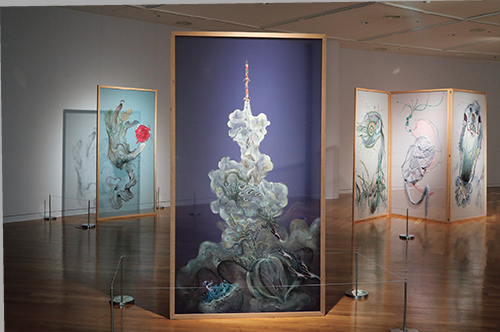
“Outside of BORA: See or Purple” by Kim Jee-soo. 2014. Gouache, collage on fabric, 216 × 118 cm (each panel).
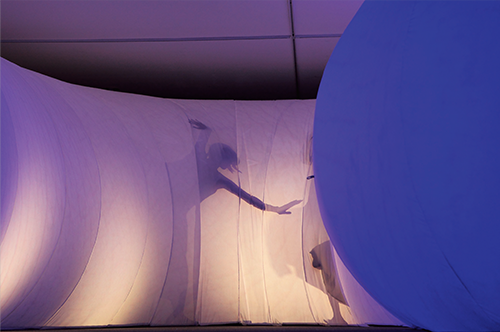
“Human & Space and Passage” by Lee Jung-yoon, Oh Sin-wook and Ahn Jae-cheol. 2018. Air molding, real-time camera, LED lighting, 20 × 10 × 20 m (variable installation in an area of this size).
The Future in Art
Kim Joon used to draw tattoos in analog fashion on the smooth surface of ceramics resembling human skin. With 3ds Max software that he learned to use at a game company, he now creates diverse variations. His digital drawings, with the texture of very delicate, brittle ceramics, portray the human body as an outer shell with no inner organs. They feature signature scenes from such classic movies as “Gone with the Wind” and “Rebel Without a Cause” to etch in the hearts of viewers a sense of nostalgia in this technology-dominated era.
A wooden fixture standing at the entrance of the museum is the work of Kang Ji-ho. It is made of scrap wood left over from installing the exhibition. The artist named the figure “Jack” and wrote up a bucket list for him. Faithfully following what is on the list, Jack is back from a belated vacation at Dadaepo Beach in Busan and is performing his duties at the museum. Entitled “Bucket List,” it looks at the possibility of regenerating art in the bigger context of sustainability; it is a heart-warming epilogue to the exhibition.
Ridley Scott’s 1982 movie “Blade Runner” is set in a dystopian future Los Angeles in the year 2019. In the movie, humans are hardly distinguishable from their replicants, or bioengineered androids, which go on living thinking that they are human. Katsuhiro Otomo’s 1988 animated post-apocalyptic cyberpunk film, “Akira,” based on his manga series of the same name, is set in Neo Tokyo 31 years after a devastating nuclear war, again in 2019. Back in 1988, people imagined that everyone would still be listening to music on CD ps and making calls from pay phones in 2019. But it is interesting how the battle scenes take place in a stadium that is being built for the 2020 Tokyo Olympics. Tokyo actually won the bid for the 2020 Olympic Games in 2013, so that part of the forecast was correct.
As such, the future that was depicted in movies of the past has now become the present. Some of the predictions were right, and some wrong. However, what holds true is that humans are mortal, but art is immortal. The artistic imagination that outlives humans retains its uniqueness and connects itself to post-human art and to the future of art.
It is a personal choice whether one’s future outlook is optimistic or pessimistic.
However, as mechanization accelerates, the value of creativity and handcraft that is contained in the archetype will rather be enhanced.
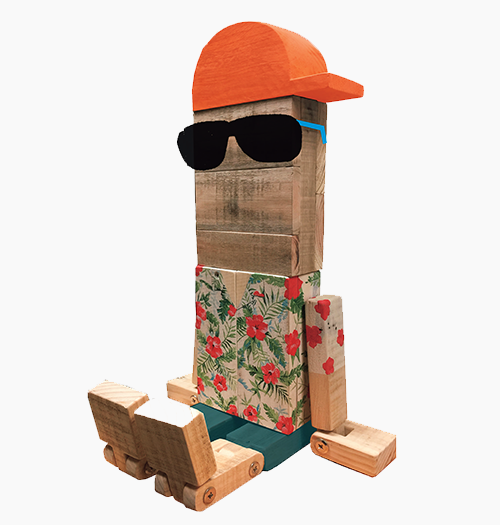
“Bucket List” by Kang Ji-ho. 2018. Acrylic paint on wood, 200 × 200 × 250 cm.
Art after Humans
Technological development surely has an impact on the arts ecosystem. The future where human labor disappears is already present in the exhibition. Not only the installation methodology but also the new concepts of the fourth industrial revolution and hyper-connected society, such as AI, the Internet of Things and big data, are embedded in the exhibits. It is a personal choice whether one’s future outlook is optimistic or pessimistic. However, as mechanization accelerates, the value of creativity and handcraft that is contained in the archetype will rather be enhanced.
The artists who are participating in this exhibition are in their 40s and 50s, on their way to becoming the “old generation.” Some works are fresh and inspiring, but the imagination in some of the works point to a future that is already past. As I make my way out of the museum, which is bustling with children from Gimhae and the local area, I am more intrigued by what kind of future those children will create.